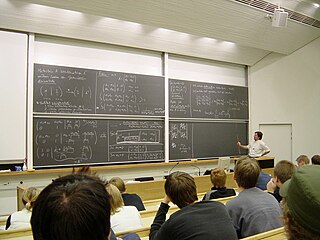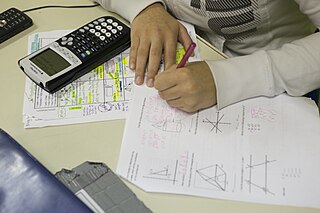A computer algebra system (CAS) or symbolic algebra system (SAS) is any mathematical software with the ability to manipulate mathematical expressions in a way similar to the traditional manual computations of mathematicians and scientists. The development of the computer algebra systems in the second half of the 20th century is part of the discipline of "computer algebra" or "symbolic computation", which has spurred work in algorithms over mathematical objects such as polynomials.
Computer science is the study of the theoretical foundations of information and computation and their implementation and application in computer systems. One well known subject classification system for computer science is the ACM Computing Classification System devised by the Association for Computing Machinery.

In contemporary education, mathematics education—known in Europe as the didactics or pedagogy of mathematics—is the practice of teaching, learning, and carrying out scholarly research into the transfer of mathematical knowledge.

A graphing calculator is a handheld computer that is capable of plotting graphs, solving simultaneous equations, and performing other tasks with variables. Most popular graphing calculators are programmable calculators, allowing the user to create customized programs, typically for scientific, engineering or education applications. They have large screens that display several lines of text and calculations.

New Mathematics or New Math was a dramatic but temporary change in the way mathematics was taught in American grade schools, and to a lesser extent in European countries and elsewhere, during the 1950s–1970s.
Principles and Standards for School Mathematics (PSSM) are guidelines produced by the National Council of Teachers of Mathematics (NCTM) in 2000, setting forth recommendations for mathematics educators. They form a national vision for preschool through twelfth grade mathematics education in the US and Canada. It is the primary model for standards-based mathematics.
Founded in 1920, The National Council of Teachers of Mathematics (NCTM) is a professional organization for schoolteachers of mathematics in the United States. One of its goals is to improve the standards of mathematics in education. NCTM holds annual national and regional conferences for teachers and publishes five journals.
Physics First is an educational program in the United States, that teaches a basic physics course in the ninth grade, rather than the biology course which is more standard in public schools. This course relies on the limited math skills that the students have from pre-algebra and algebra I. With these skills students study a broad subset of the introductory physics canon with an emphasis on topics which can be experienced kinesthetically or without deep mathematical reasoning. Furthermore, teaching physics first is better suited for English Language Learners, who would be overwhelmed by the substantial vocabulary requirements of Biology.

Bergen County Technical High School, also known as Bergen Tech (BT), is a four-year, tuition-free public magnet high school located in Teterboro, New Jersey serving students in ninth through twelfth grades in Bergen County, in the U.S. state of New Jersey. Bergen Tech is part of the Bergen County Technical Schools, a countywide district that also includes Bergen County Academies in Hackensack, Applied Technology in Paramus, and Bergen Tech in Paramus. The school is nationally recognized, as students have the opportunity to be engaged in a technical major while fulfilling college preparatory classes and having the opportunity to take a wide variety of electives.
Saxon math, developed by John Saxon (1923–1996), is a teaching method for incremental learning of mathematics created in the 1980s. It involves teaching a new mathematical concept every day and constantly reviewing old concepts. Early editions were deprecated for providing very few opportunities to practice the new material before plunging into a review of all previous material. Newer editions typically split the day's work evenly between practicing the new material and reviewing old material. It uses a steady review of all previous material, with a focus on students who struggle with retaining the math they previously learned. However, it has sometimes been criticized for its heavy emphasis on rote rather than conceptual learning.

Racket is a general-purpose, multi-paradigm programming language and a multi-platform distribution that includes the Racket language, compiler, large standard library, IDE, development tools, and a set of additional languages including Typed Racket, Swindle, FrTime, Lazy Racket, R5RS & R6RS Scheme, Scribble, Datalog, Racklog, Algol 60 and several teaching languages.
The ProgramByDesign project is an outreach effort of the PLT research group. The goal is to train college faculty, high school teachers, and possibly even middle school teachers, in programming and computing.

Times2 STEM Academy is a charter school in Providence, Rhode Island that specializes in teaching science, technology, engineering, and mathematics.

Core-Plus Mathematics is a high school mathematics program consisting of a four-year series of print and digital student textbooks and supporting materials for teachers, developed by the Core-Plus Mathematics Project (CPMP) at Western Michigan University, with funding from the National Science Foundation. Development of the program started in 1992. The first edition, entitled Contemporary Mathematics in Context: A Unified Approach, was completed in 1995. The third edition, entitled Core-Plus Mathematics: Contemporary Mathematics in Context, was published by McGraw-Hill Education in 2015.

Bradley Efron is an American statistician. Efron has been president of the American Statistical Association (2004) and of the Institute of Mathematical Statistics (1987–1988). He is a past editor of the Journal of the American Statistical Association, and he is the founding editor of the Annals of Applied Statistics. Efron is also the recipient of many awards.

Mathematics education in the United States varies considerably from one state to the next, and even within a single state. However, with the adoption of the Common Core Standards in most states and the District of Columbia beginning in 2010, mathematics content across the country has moved into closer agreement for each grade level. The SAT, a standardized university entrance exam, has been reformed to better reflect the contents of the Common Core. However, many students take alternatives to the traditional pathways, including accelerated tracks. As of 2023, twenty-seven states require students to pass three math courses before graduation from high school, while seventeen states and the District of Columbia require four. A typical sequence of secondary-school courses in mathematics reads: Pre-Algebra, Algebra I, Geometry, Algebra II, Pre-calculus, and Calculus or Statistics. However, some students enroll in integrated programs while many complete high school without passing Calculus or Statistics. At the other end, counselors at competitive public or private high schools usually encourage talented and ambitious students to take Calculus regardless of future plans in order to increase their chances of getting admitted to a prestigious university and their parents enroll them in enrichment programs in mathematics.
Statistics education is the practice of teaching and learning of statistics, along with the associated scholarly research.
Bootstrapping is a self-starting process that is supposed to proceed without external input.
The Secondary School Mathematics Curriculum Improvement Study (SSMCIS) was the name of an American mathematics education program that stood for both the name of a curriculum and the name of the project that was responsible for developing curriculum materials. It is considered part of the second round of initiatives in the "New Math" movement of the 1960s. The program was led by Howard F. Fehr, a professor at Columbia University Teachers College.
EarSketch is a free educational programming environment. Its core purpose is to teach coding in two widely used languages, Python and JavaScript, through music composing and remixing. This learning environment was developed first at Georgia Institute of Technology, under Prof. Jason Freeman and Prof. Brian Magerko.









